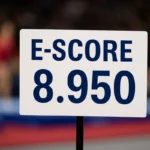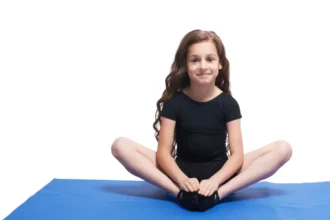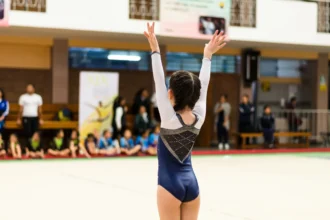In artistic gymnastics, every routine is judged through a balance of difficulty and execution. Fans often hear about gymnasts “losing points” but may not know whether those points come from execution mistakes or neutral deductions.
The distinction is important because E-score deductions and neutral penalties come from different judging panels, are applied for different reasons, and affect the final score in different ways.
What Are E-Score Deductions?
The Execution Score (E-score) always begins at 10.0. Judges then subtract for technical and artistic faults seen during the routine. These deductions measure how well a gymnast performs the elements, not whether the routine followed the rules.
Common E-Score Deductions
- Form errors: bent arms, bent knees, flexed feet (−0.10 to −0.30).
- Amplitude errors: skills done too low, not reaching handstand (−0.10 to −0.30).
- Balance errors: wobbles on beam or steps on landings (−0.10 to −0.30).
- Large faults: falls, hands down, incomplete twists (−0.50 to −1.00).
Key Points
- Applied by the E-judging panel (multiple judges, averaged for fairness).
- Can range from tiny 0.10 deductions to large 1.00 falls.
- Affect only the E-score portion of the routine, not the difficulty.
Example: A gymnast has a near-perfect beam routine but takes one large step on dismount. Judges might take −0.30 off the E-score, dropping it from 9.3 to 9.0.
What Are Neutral Penalties?
Neutral deductions are rule-based penalties that don’t depend on execution or artistry. Instead, they enforce competition guidelines like time limits, equipment use, and floor boundaries.
Common Neutral Penalties
- Out-of-bounds: stepping outside the white border on floor or off the mat on vault (−0.10 each step).
- Overtime: beam or floor routine exceeding the time limit (−0.10).
- Undertime: routines not meeting the minimum time (−0.10).
- Coach assistance: spotting the gymnast (−0.50).
- Wrong equipment use: incorrect matting, springboard, or starting position (−0.30 to invalidation).
Key Points
- Neutral penalties are not tied to the E-judges.
- Applied directly by the head judge or neutral panel.
- Always come off the final score, no matter how well the routine was executed.
Example: A gymnast performs a flawless floor routine (9.5 E-score) but lands one tumbling pass with a toe outside the line. A −0.10 neutral penalty drops the final score from 14.5 to 14.4.
E-Score vs. Neutral: The Core Difference
| Aspect | E-Score Deductions | Neutral Penalties |
|---|---|---|
| What they judge | Quality of performance (form, artistry, landings) | Rule compliance (time, boundaries, equipment) |
| Who applies them | E-judging panel | Head judge or neutral panel |
| Starting point | Subtracted from 10.0 (execution score) | Subtracted from the final score |
| Typical size | 0.10 to 1.00 | 0.10 to 0.50 (sometimes higher) |
| Examples | Bent knees, steps, falls | Out-of-bounds, overtime, coach on floor |
How Each Affects the Final Score
In gymnastics, a gymnast’s total score is built step by step, and each type of deduction plays a distinct role in that calculation. The score is assembled in the following order:
- D-score (Difficulty): This is based on the hardest skills performed, connection bonuses, and required elements. It has no upper limit.
- E-score (Execution): This always begins at a perfect 10.000, and judges subtract for form, posture, artistry, and technical errors throughout the routine.
- Neutral deductions: These come off last, after the D and E panels have finalized their values.
The formula looks like this:
Final Score = D-score + (10.000 – execution/artistry deductions) – neutral penalties
Why Order Matters
The order of deductions affects strategy. Neutral penalties come straight off the bottom line, so they erase value from both difficulty and execution at once. You cannot “out-execute” a neutral penalty. Even a flawless routine with no visible errors will drop in score if the gymnast steps out of bounds, runs overtime, or violates attire rules.
What You Can and Cannot Protest
Not every deduction is open for review. Inquiries are designed to challenge judgment calls or scoring math, not clear-cut rule violations.
✅ Inquiries Allowed (D/E Panel Judgments)
- Skill value: Was a skill undervalued (e.g., credited as a C instead of a D)?
- Connection bonus: Did the panel miss awarding a bonus?
- Composition requirements: Did the gymnast meet all required groups?
- Execution/artistry deductions: Was the routine penalized too harshly, or did judges miss a visible error?
- Score calculation mistakes: Arithmetic or averaging errors in the final tally.
🚫 Inquiries Not Allowed (Neutral Penalties)
Neutral deductions are objective and final. They are enforced by the Chief Judge or auxiliary judges (line or time judges), not the E-panel, and cannot be overturned:
- Stepping or tumbling out of bounds
- Overtime on beam or floor
- Undertime if routine is too short
- Improper attire or visible jewelry
- Starting before/after the judge’s signal
- Second run-up on vault
- Coach interference, spotting, or giving verbal cues
FAQs:
Q: Why can’t neutral penalties be challenged?
A: Because they are objective. A foot is either over the line or not. Time ran over or it didn’t. These are black-and-white rulings enforced by line or time judges, not subjective calls.
Q: Which has a bigger impact on the score?
A: It depends. A fall (−1.00 E deduction) is much larger than a boundary step (−0.10 neutral). But neutral penalties can be decisive in close competitions because they subtract directly from the final score, even if the gymnast executed perfectly.
Q: Does NCAA use neutral penalties too?
A: Yes. College gymnastics follows its own modified Code of Points but still applies neutral deductions such as out-of-bounds (−0.10), overtime (−0.10), and coach interference.
Q: Do neutral penalties vary by apparatus?
They do. For example, floor and vault often see out-of-bounds deductions, while beam can involve overtime or short routine penalties. Bars usually avoid neutral penalties unless there’s a major timing or coach-related issue.
Q: What’s the best way for gymnasts to avoid neutral penalties?
A: Practice awareness—train with marked boundaries, time routines in practice, and rehearse competition rules (signals, attire, equipment setup). Preventing neutrals protects hard-earned tenths from execution.
In Summary
E-score deductions measure how well a gymnast performs, while neutral penalties measure whether they followed the rules. Both are crucial in creating a fair and balanced scoring system, but they operate on different parts of the score sheet.












